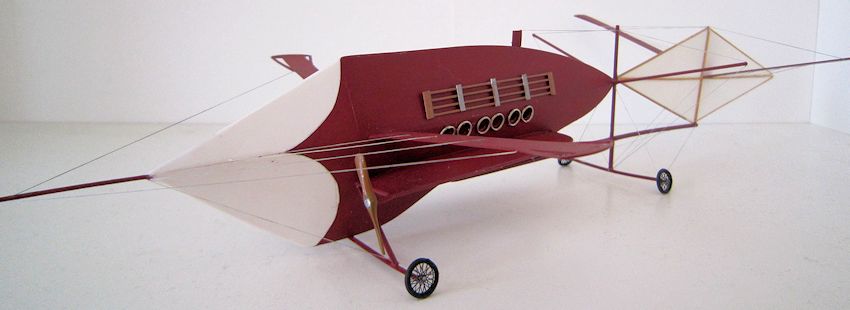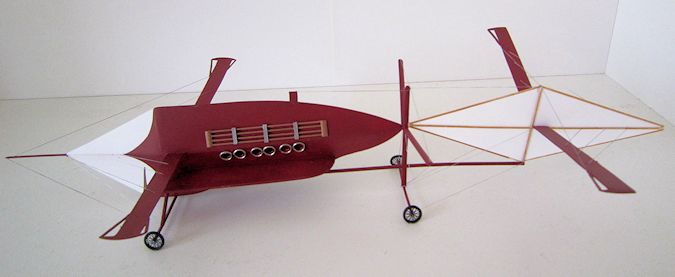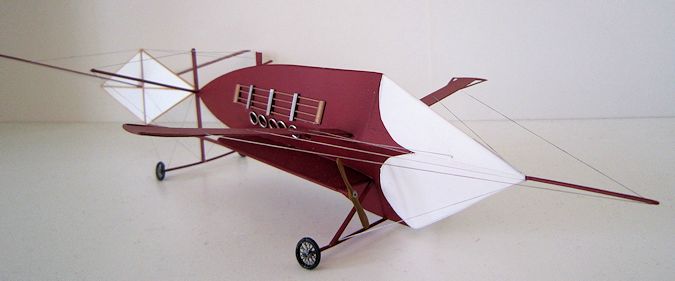
| KIT #: | |
| PRICE: | |
| DECALS: | None required |
| REVIEWER: | Chris Peachment |
| NOTES: |
Made from 10 and 20 thou plastic card, rod and strut |

| HISTORY |
No, this is not the CGI picture of a machine from the next film adaptation of a Jules Verne classic. It existed, though it never flew. I would not normally make a model of an aircraft that never flew, since there are quite enough of those that did, but one look at this magnificent beast, and I realised I had to see what it looked like in three dimensions.
John F. Cooley began construction of his Airship in 1910 near the Genesee Valley Park at Rochester, New York, where he promised that the trial flight would eventually take place. You can see him in some of the photographs, wearing a bowler hat, a huge overcoat, and smoking a cigar. He looks every inch a con man.
 The design was vast,
and so different from anything that had previously been attempted, it would
surely make his investors rich, or so he claimed. Cooley's creation was 81 foot
long and 42 foot wide, and had a crew of pilot and engineer. He sold it to the
local newspaper as "the first 'All Rochester' plane."
The design was vast,
and so different from anything that had previously been attempted, it would
surely make his investors rich, or so he claimed. Cooley's creation was 81 foot
long and 42 foot wide, and had a crew of pilot and engineer. He sold it to the
local newspaper as "the first 'All Rochester' plane."
Alas, Mr Cooley disappeared in April, 1911 with outstanding debt. His then unpaid crew in Rochester abandoned their work on the unfinished airship. It was transferred from Cooley's ownership to a local grocer, to whom he owed $92. I would say that, even at the then worth of the dollar, the grocer got a bargain, though I dare say it was one he didn't much want.
Cooley was later sighted in New York City selling stock in an airship enterprise. What happened to him after that is lost to history. The All Rochester Airship and its hangar were destroyed by a storm.
Mr Cooley was clearly one of those men who could talk up a storm. He claimed that his flying machine would be capable of making a flight of 1,000 miles. His machine was different from all others in that it was fitted with a closed car designed to carry a pilot, an engineer and three passengers and was fitted with two Elbridge 90 horsepower engines. He was ready to try his machine on April 15, and if the test was successful, he proposed to fly it to New York City. That fateful day came and went.
By May he reported that he needed another $6,000 to finish the project, so would travel to New York to seek more financing. After that he was never seen again.
 The unemployed employees of Cooley
did the sensible thing of charging 10 cents to view the craft and even look into
its inner mysteries. "Parties of girls went into raptures over it, admiring its
two propellers and its huge front and rear planes of oiled silk." You can just
picture them doing it.
The unemployed employees of Cooley
did the sensible thing of charging 10 cents to view the craft and even look into
its inner mysteries. "Parties of girls went into raptures over it, admiring its
two propellers and its huge front and rear planes of oiled silk." You can just
picture them doing it.
How anyone thought that a beast this size could ever take to the air with such miserable wings and low powered engines is a mystery. Since it is called an Airship, one assumes that there must have been provision for gas bags inside the fuselage, although interior photos show nothing. There is no mention of them in any text. If he had put hydrogen balloons inside that vast hull, then it might just have floated off the ground, and made some headway from its two propellers. But then again, maybe not.
| CONSTRUCTION |
I could find no plans of this dream machine, but fortunately there are some excellent high quality photographs on the websites below, together with dimensions of the Airship. Mark out the length and height on a large sheet of graph paper and then map out the shape, using the pictures of the men standing beside the aircraft and judging their height to be about five foot ten. Then turn pale when you realise that it is more than 10 feet longer than a Lancaster bomber.
 Construction began by
making a base plate for the interior, which is an elongated diamond shape and
will fit amidships. The exterior sides can then be cut to shape from eight
pieces of card, four for each side. Glue the upper fuselage plates to the base
plate and then join them at the top. Repeat for the lower half. And in no time
you have the diamond shaped beastie that puts you in mind of those ironclad
warships of the US Civil War.
Construction began by
making a base plate for the interior, which is an elongated diamond shape and
will fit amidships. The exterior sides can then be cut to shape from eight
pieces of card, four for each side. Glue the upper fuselage plates to the base
plate and then join them at the top. Repeat for the lower half. And in no time
you have the diamond shaped beastie that puts you in mind of those ironclad
warships of the US Civil War.
Before doing that however, you should have cut out the portholes down each side with a sharp scalpel. There does not seem to be any forward windscreen, so unless the front half of the machine was covered in translucent silk, then the crew would have been doomed to fly it without knowing where they were going. Still, Charles Lindberg later did wonders without a windscreen.
The tail boom is a long piece of rod attached below, and held in place by a vertical rod attached to the rear end of the main body. The huge tail planes were made from thin card surrounded and cross-rigged with rod painted wood brown. They are best set aside now, because the attachment to the main body seems to be only two tiny points. How it would have held together in rough weather is fortunately something that was never put to the test.
The main body was now masked off and painted, in white from a rattle can, and in that lovely shade of burgundy, which is from Citadel and is called Khorne Red, whatever that means. I am guessing from the black and white photographs that the machine was red, but if anyone tells me it was ultramarine, I will take their word for it. I can find nothing in print to describe its colour, but it strikes me that it ought to be something exotic.
 Once dry, the
portholes can be glazed with Humbrol Clearfix. The circular surrounds are made
from solder, wrapped around a paintbrush. The side radiators were made from thin
rod and scrap plastic appropriately painted in silver and copper. And that is
more or less the main fuselage finished.
Once dry, the
portholes can be glazed with Humbrol Clearfix. The circular surrounds are made
from solder, wrapped around a paintbrush. The side radiators were made from thin
rod and scrap plastic appropriately painted in silver and copper. And that is
more or less the main fuselage finished.
The very thin chord wings were cut from plastic card, together with the odd little struts at each end. Note they are different lengths and chords.
Now comes the ticklish business of joining them all together. I wish I could say that I have a special jig made of brass-mounted mahogany, which I always employ at this point when making biplanes, but I am afraid that I never grew up enough to get one of those, and always make do with some carefully arranged paperback books. The attachment of the tail and then the thin wings is best done first with polystyrene cement to fuse the plastic together. I then strengthened each joint with layers of superglue. It hasn't yet sprung apart, but whenever I handle it, it wobbles around alarmingly. So I don't handle it.
The machine also had
stub wings, which look like flying boat sponsons, on each side. At the front of
each is mounted a two blade propeller, presumably driven by chains or some other
“suitable system of levers” from inside.
chains or some other
“suitable system of levers” from inside.
A couple of simple axles make up the undercarriage, together with some spoke wheels from an Eduard etched set. Notice that they are heavily knock-kneed, as the weight of this monster would surely have needed far more by way of undercarriage. Like two B-52 bogies, perhaps?
A nose probe was added, to make it look even more like the Nautilus submarine from 20,000 Leagues Under the Sea. And finally a little rigging was added, though not very much is visible from the photographs.
| CONCLUSIONS |
For some reason neither Airfix nor Tamiya have ever included this one in their catalogues, which is surely a shameful omission. It must be top of the wanted list of so many modellers. So if you would like one, then scratchbuilding is the only way to go. It was surprisingly easy, given that there are so few parts and no compound curves. For once, it was so large that I didn't need an extra pair of reading glasses. The trickiest and lengthiest part of the build was drawing up the plans, but that too was highly enjoyable, because of the joys of interpreting the details from photographs.
Who cares if it never flew? It did in Mr Cooley's dreams.
| REFERENCES |
http://www.wright-brothers.org/History_Wing/Aviations_Attic/UFOs/UFOs.htm
http://bassman5911.tumblr.com/post/32712355934/the-cooley-airship-overall-length-81-width-421
http://www.aerofiles.com/_cl.html
http://therochesterinsomniac.com/2012/09/14/holy-fuck-rochester-cooleys-airship/
http://meinekleinefabrik.blogspot.gr/2012/10/the-cooley-airship.html
August 2015
If you would like your product reviewed fairly and fairly quickly, please
contact
the editor or see other details in the
Note to
Contributors.